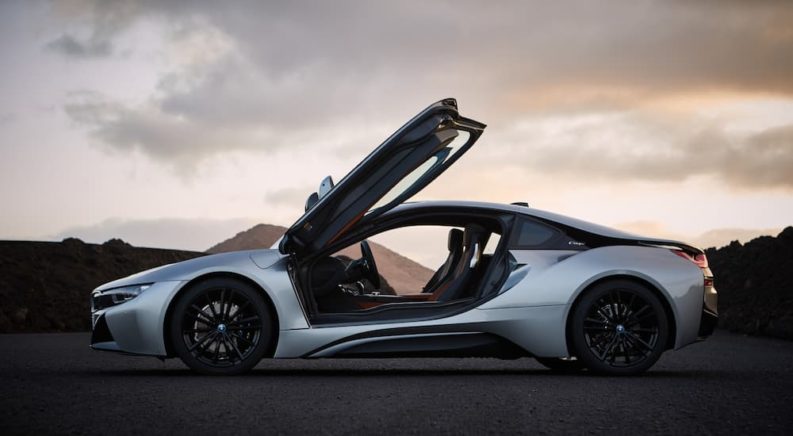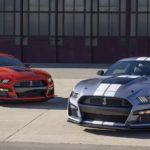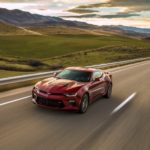I may be alone here, but I imagine that there’s at least one other science fiction fan like me browsing the offerings at a used car dealership. They may not be able to buy the spacecraft of their dreams, but the next best thing would be a car that resembles a rocket ship in some shape or form. Each of these discontinued cars checks that box, and I’d be over the moon if any of them were to make a comeback. From oddities of body design to features that were intended to seem futuristic, each of these classics had some creative features. I’m probably not the only one who’d like to see these return from the depths.
Oldsmobile 88
The Oldsmobile 88 (AKA Rocket 88) landed in 1949, 20 years before humankind would step foot on the moon. Even so, it carved out a place of its own in the history books by becoming what many consider to be the first muscle car. The explosive formula comprised of a lightweight body and big V8 was pioneered by the Olds 88. Its out-of-this-world power swept the nation off its feet, and it wasn’t long before the Rocket 88 was the competitor to beat at NASCAR, taking home ‘dubs for 10 out of 19 races during the 1950 season. It even served as inspiration for one of the world’s first rock n’ roll songs, Jackie Brenston’s “Rocket 88”.
It’s been a couple of decades since new 88s have rolled off the lots, and the sun has long since set on the glory days of the fiery, first-generation Rocket 88. The Oldsmobile brand doesn’t exist anymore and even if it did, the EPA would never allow the revival of something as environmentally unfriendly as the heyday muscle cars. Still, I imagine seeing a brand-new Rocket 88 on the road would be a sight as glorious as beholding Halley’s Comet—maybe even more so.
Chevy Lumina APV
What do you mean, minivans don’t look like anything like rocket ships? Okay, so maybe they’re almost the perfect opposite to ultra-expensive machines ripping through the sound barrier and speeding into the dangers of the great unknown. But as far as minivans go, the Chevy Lumina APV was about as Jetsons as it gets.
The sci-fi marketing theme employed in the 1990s by GM during the minivan’s 7-year run doesn’t hurt, and even the name “Lumina” brings to mind images of stars twinkling in the distance. One of the most distinctive features of the Lumina is the large windshield, which not only provides abundant views to whoever sits in the cockpit, but also slopes down smoothly into the front end, creating the look of a forehead of Roswellian proportions. Call me nostalgic, but I sort of resent the SUV invasion that has displaced the minivan as America’s favorite family carriage. As the vessel of choice for many a road trip taken during my own childhood, the minivan felt something like a spaceship, cruising my family and me (safely) from one adventure to the next—in a chasm of ample seating space.
Audi A2
The Audi A2 may not look like much, but underneath its pod bod is a motherlode of high-end tech. Its body is constructed with a large amount of aluminum, making it less susceptible to gravity than other, heavier cars. It utilizes the Audi Space Frame, engineered specifically to find a winning balance between strength and lightness. This grants the A2 a high level of fuel efficiency, as does its aerodynamic design.
Its spacious interior defies physics, being incredibly roomy despite its status as a supermini car. Its tall build provides enough head room for even the vertically gifted among us, and the floor in the rear sits lower than the front, creating more leg room. The rear seats can fold down or be removed completely to ramp up cargo space, as well.
Another out-of-this-world feature is the A2’s service hatch. Instead of wrenching the whole hood open and exposing the entirety of the car’s inner workings, the A2 has a small panel by the grille that can be flipped open for access to fluids, which is all that the large majority of drivers need to access on their own. The hood still comes off in case repairs are needed, but we’ll leave that to the trained professionals and garage mechanics. Although the A2 was impeccably designed, sales were underwhelming and it never made it to the American market. I have a feeling that if this vehicle were reintroduced in today’s efficiency-favoring market, it may have a more successful run.
Volkswagen XL1
Even though it was designed for use on roads only, the smooth and streamlined VW XL1 definitely looks like something capable of gliding through our upper atmospheres. Sold in Europe from 2013 until 2016, the XL1 was marketed as the “1-liter car”, promising a 283 MPG range for the turbo-diesel plug-in hybrid.
Its efficiency is due in part to its tiny stature. It seats 2 passengers, tandem-style, keeping the wheelbase a minuscule 87.6”. It’s also only 45.4” tall, so prepare to duck if you ever find yourself boarding this scarce-craft. The XL1 is interesting, to say the least, and I’d love to see VW bring it back in some shape or form. Its lightweight body offers something different from the heavy metal EVs and hybrids on the market today, and I could even get behind the tandem seating style, literally. In a nation full of commuters and vehicles with single occupancy, it’s kind of a wonder that this style of seating hasn’t become more popular.
BMW i8
The BMW i8 is a snazzy sports car that was sold in either coupe or roadster body styles. It’s a clean and mean plug-in hybrid with fuel efficiency rated at 112 MPG, but its styling is what sets this vehicle apart from other earthly modes of transportation. Although its flat profile and curvaceous air ducts certainly make the i8 stand out, it manages to achieve that plucked-out-of-the-future look without being over-the-top.
Its unique styling is exactly what enables the i8 to slice through the air like a machete—its drag coefficient is a mere 0.26. It was also the first production vehicle to sport laser headlights, which create more light while using less energy than LED headlights. To top things off, gullwing doors open up towards the skies, giving onlookers the impression that the i8 is readying itself for flight. The i8 was in production from 2014 until 2020, and although it hasn’t been gone for long, my fingers are crossed for a revival in the near future.
Comeback to the Future
Exhuming a bygone classic can produce mixed results, either tarnishing a legacy or breathing new life into it. Lately, a lot of nameplates have been dusted off and pulled out of retirement—and pretty successfully, too. The forward-thinking theme employed by all of these vehicles makes them perfect candidates for a comeback.
Certainly, there’s much to be said about consumer tastes and environmental restrictions changing. However, some positive engineering may have been tossed out with the rubbish as these vehicles faded into the history books. Some car stars are best left in the past, but others have the potential to flourish again, shining even brighter than they did before.




